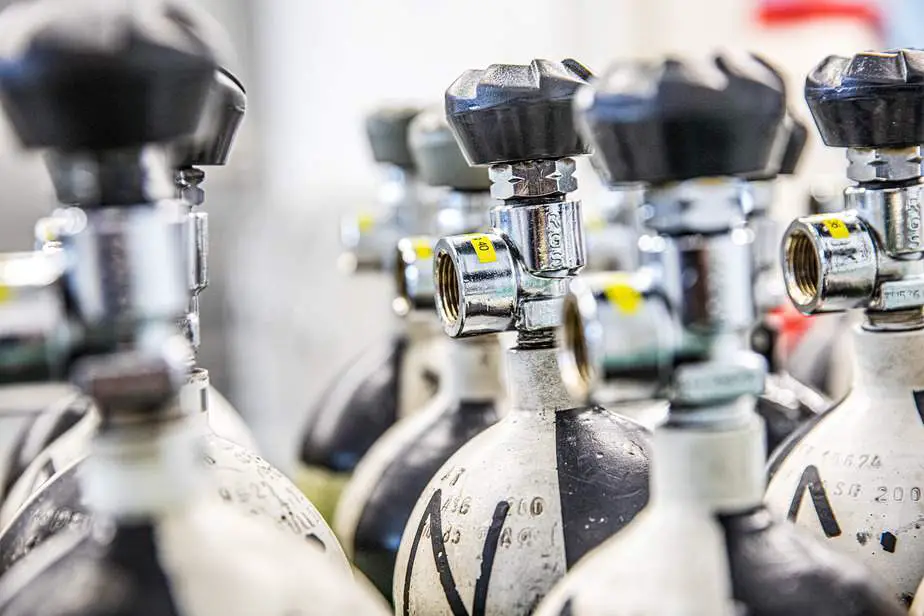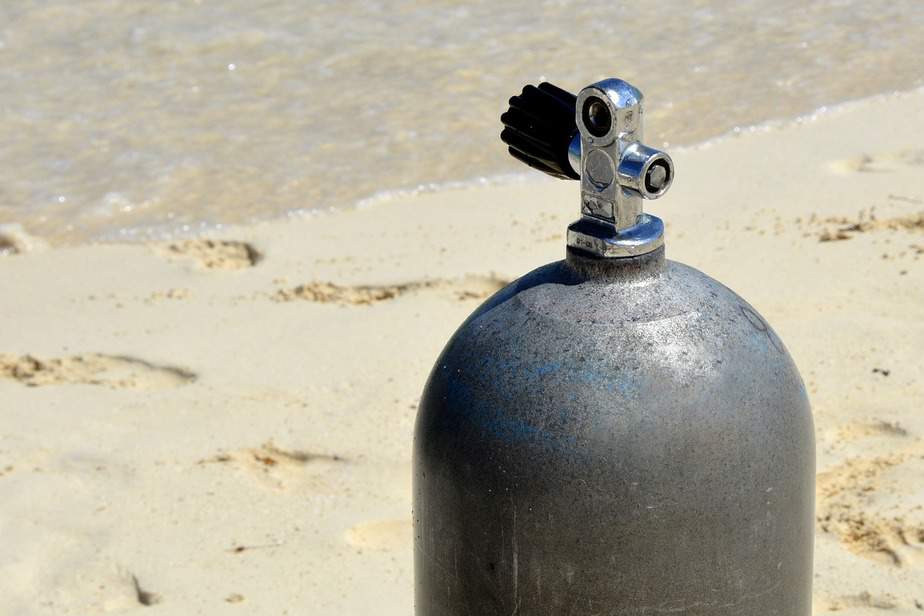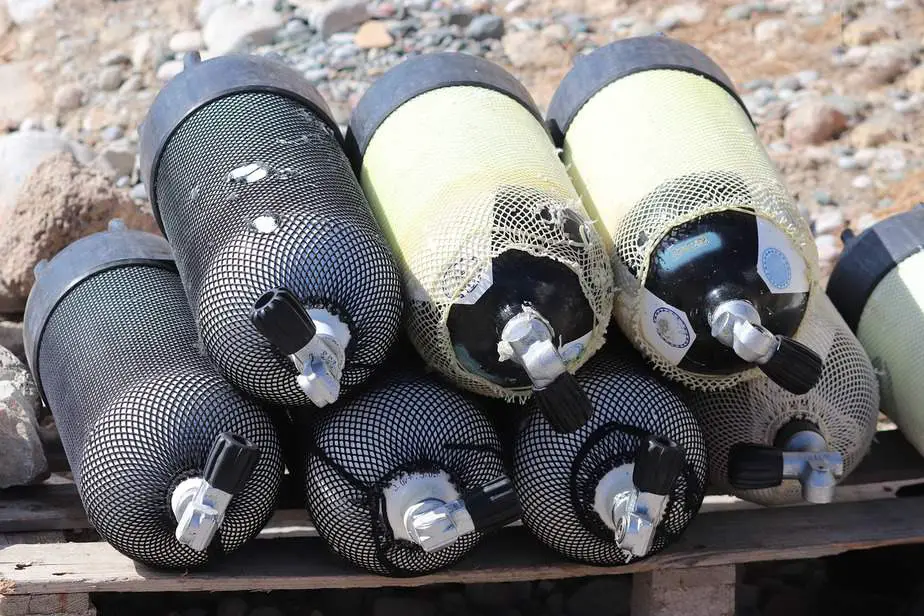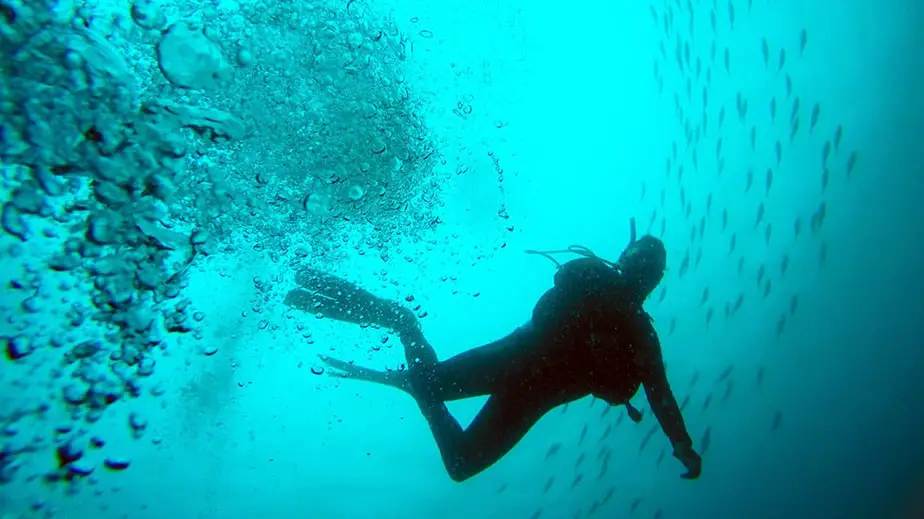Thanks to movies like Jaws or any action film where pressurized cylinders get shot, most people are aware that scuba tanks can explode. At the same time, of course everyone should know better than to believe everything that happens in movies and TV shows because they are fictitious, done for entertainment, and not always scientifically accurate. However, this is one topic where they aren’t wrong. Scuba tanks can and have exploded in real life, often with deadly consequences. This is something to be taken seriously.
In this article, we’ll discuss scuba tank explosions – can they happen? What causes them to happen? How can we prevent them from happening? We’ll answer these questions and more.
Portrayal of tank explosions in entertainment – any truth?
A personal anecdote: When I first started scuba diving, it wasn’t the fear of drowning, or running out of air, or encountering a shark, or the abyssal depths of the ocean that scared me the most. My number one fear was that my scuba tank would suddenly explode, turning me into red mist in a fraction of a second and snuffing out my incredibly bright future.
I know this fear originated when I saw Jaws as a young boy, and since then I knew for a fact that scuba tanks could explode. If a scuba tank explosion could literally blow a monstrous great white shark to bits, I stood no chance whatsoever.
There were also no shortage of action movies where shooting a pressurized tank caused a group of people to blown to pieces. Or movies where the tank valve was cut off and the cylinder shot out like it was a missile, leaving a wake of destruction in its path.
The way pressurized cylinders were portrayed in media put the fear of God into me, and every time I saw somebody carelessly handle a scuba tank or witnessed a tank falling over, I winced. I literally thought that at any moment, a nearby tank would explode from getting dented, scratched up, or because the material finally gave out, and I didn’t want to be there when it happened.
Each time I went scuba diving, it felt like I was strapping a live bomb to my back, and the only thing keeping me sane was the rational part of my brain telling me that Jaws isn’t realistic. I was perhaps a little too paranoid, but the physics behind a scuba tank explosion is definitely real.
Do scuba tanks actually explode?

Yes, they do. A quick search on Google will return many news stories of people who were unfortunate victims of scuba tank explosions. Anyone who is well-versed in physics also knows that when a gas is compressed and stored at high pressures, there is a chance of an explosion either from the gas combusting (e.g. pure oxygen which is highly flammable) or the force of all that pressure being released at once.
Most of the time when tanks explode, it’s the latter kind of explosion and less of the former. Typically, a tank explodes due to impact damage or rust weakening it until it can no longer contain the pressure inside. For instance, the cylinder could have been punctured, dented (e.g. from being dropped or from something hitting it), corroded by moisture, or scratched. The tank could have also been overpressurized from being improperly filled, exposed to heat causing the gasses inside to expand, or the valve was damaged.
The fiery kind of explosion you see portrayed in the media can also happen, but there would need to be some kind of spark or open flame coming into contact with the gasses inside to create an explosion.
Regardless of what kind of explosion it is, an explosion is an explosion – they are very deadly and even if you manage to survive, it is highly likely you will be maimed or badly burned.
You might be wondering, between the two most common types of scuba tanks: a steel tank and an aluminum scuba tank, which one is more likely to explode than the other? Which is more durable? Which type of tank is the best? There are pros and cons to both.
How likely is it for steel tanks to explode?

Steel tanks are tough. Even though aluminum tanks tend to be heavier, the reason is that aluminum is a weaker material, so more of it is needed to create thicker walls, making them heavier overall. Steel, being the stronger material, can be a lot thinner and produce similar results. How lightweight steel tanks are compared to aluminum make them more enjoyable to dive with. Also, steel tanks are not as buoyant, but that just means you need less dive weights.
That said, steel has an obvious downside – it is more susceptible to the corrosive properties of saltwater. Even though steel tanks theoretically have a long lifespan of several decades, it is rarely used that long because during that long span of time, it’s highly possible it would fall victim to corrosion from improper care.
If you are not careful, saltwater or moisture may corrode the exterior or interior of the tank, weakening the integrity of the tank walls. Should the tank walls weaken sufficiently, it’s possible that an explosion could occur.
How likely is it for aluminum tanks to explode?
On the other hand, aluminum tanks are more resistant to saltwater’s corrosive properties. As we mentioned, aluminum is weaker than steel, so to compensate, manufacturers have to add multiple layers on top of each other to make the walls thicker, strengthening it. This comes with the downside of aluminum tanks being heavier and having less air capacity, but not by much.
The many layers of aluminum further boost its corrosion-resistant capabilities. When rust does form on aluminum, it will form on the outer layer and oxidize it, forming a protective layer that further resists corrosion. This means that an explosion caused by rust is much more unlikely to occur in aluminum tanks.
With that said, aluminum is still the weaker material. Unlike the resilient steel tanks, aluminum is more susceptible to impacts, such as any drops or hits against it. If there is any major impact on an aluminum tank, it will likely be unusable. It’s possible that an aluminum tank explosion can occur if it gets hit by something hard.
What are the chances of a scuba tank explosion?

There isn’t an official statistic on how many tanks explode versus how many don’t, and if there were, then it would say that the overwhelming majority of tanks don’t explode.
Plus, considering how many millions of people go scuba diving each year, and how many other applications pressurized cylinders are used in (e.g. the medical field, the scientific field, the military, paintballing, etc.), the fact is if pressurized cylinders had a high risk of failure, we would have invented something better already and recalled all faulty tanks.
Plus, dive shop employees who fill your tanks also share the same fear I did (except they have very good reason to be scared since they don’t know how well the customer maintained their tank). That’s why scuba tanks need to pass two tests before a dive shop will fill the tank: a visual inspection and a hydrostatic pressure test. These tests are designed to protect everyone who will be handling the tank in the future.
During a hydrostatic pressure test, your tank will be overfilled beyond its rated capacity by 50% under a safe environment by a skilled technician. It’s very possible your tank will explode here, in which case it will be condemned and no one is injured. You won’t have a tank anymore, however, but at least it didn’t explode next to you. Passing both these tests will help ensure that a scuba tank won’t explode unexpectedly while you’re unloading it from your car or in the middle of a dive.
Since dive shops won’t even fill the tank if it doesn’t have a valid stamp/sticker, meaning that it passed the hydro test and visual inspection recently, then you don’t have to worry so much about tanks exploding unless you are doing an absolutely terrible job maintaining it in which case, why don’t you just rent the scuba tanks and let the dive shop employees handle maintenance?
A special warning: 6351 aluminum alloy tanks
My worst fears had become reality when I learned about the 6351 aluminum alloy tanks made by Luxfer, Walter Kidde, and others. Catalina is sometimes named alongside them but this is a mistake.
Tanks made of 6351 aluminum alloy are susceptible to sustained load cracking (SLC) which is when the material develops cracks over time when placed under stress. Once the crack grows big enough, the tank will be unable to contain the pressure inside and explode.
Unfortunately, some people found out the hard way when their 6351 aluminum alloy cylinder unexpectedly exploded. Over the years, more than of handful of people have been injured or killed by it even though it was recalled. Not everyone got the message, or they just simply didn’t care. To this day, there are still some cylinders made of 6351 alloy still circulating the market, and people who are buying used scuba tanks might accidentally purchase this ticking time bomb.
How do you know if a tank is made of 6351 aluminum alloy? Read this post on the Luxfer website. They state that the tanks they made between the years of 1987-1988 were made from 6351 alloy, and that you should avoid using them. Conversely, that means that any models made before 1987 and after 1988 were made using their proprietary and safe 6061 aluminum alloy. However, any Luxfer models manufactured during those two years are susceptible to SLC, meaning they are liable to explode.
If your Luxfer cylinder model is listed below, it is made from 6351 aluminum alloy; stop using it immediately!
| Models | Date discontinued |
| S30, S63 | May 1988 |
| S40 | June 1988 |
| S50, S92 | April 1988 |
| S72, S100 | August 1987 |
| S80 | January 1988 |
| S808 | May 1987 |
If you do happen to own a tank made with 6351 alloy, don’t freak out. SLC is a very slow process which can take close to a decade before it reaches a critical point. You don’t have to scrap your 6351 tank just yet.
In the meantime, you should get your 6351 tank inspected with an Eddy test. This is when a technician uses an eddy-current device which can detect hard-to-see sustained-load cracks in your tank. This test should be done in addition to your usual visual inspections and hydro tests. Assuming your 6351 tank passes the Eddy test, then congratulations, you are one of the lucky ones.
Common causes of scuba tank explosions
Punctured tanks
If a scuba tank should somehow get punctured, then it would immediately cause a decrease in the pressure level inside the tank as all of the gas releases, causing an explosion.
As such, keep tanks far away from any sharp objects that could puncture it, such as any drills, nails, metal bars, and so on.
It’s also why you must be so careful if you will be transporting the tank by car. In the event you get into a car accident, it’s highly likely that a tank will get punctured, and if the gas meets a spark, you will get an actual fiery explosion.
Over-pressurized tanks
Every scuba tank has a pressure rating – a designated “safe” limit to which it can hold oxygen safely. If this limit is ignored and filled beyond what it’s rated for, then it can lead to an explosion. That said, chances are you are bringing your tank to a dive shop where a trained employee will do the filling, so they need to be careful not to overfill it.
Every 5 years, each tank must undergo a hydrostatic pressure test. This is a mandatory test, and dive shops will not fill your tanks unless you have a valid hydro pass and visual inspection sticker/stamp.
During the hydro test, a tank will be purposely filled to 150% of its pressure rating in a controlled environment. If it manages to withstand overpressurization (measured by how much the tank bends), then it passes the hydro test. However, there is a possibility it fails, in which it might explode or it is condemned. Obviously, you will no longer have the tank anymore, but at least no one was injured by it.
Overheated tanks
Tanks that are kept in a warm environment are at risk of exploding. Warm temperatures will cause the gas inside to expand, increasing the pressure. That means that the tank is potentially subjected to pressure ratings it’s not designed for, and not in a safe environment like a hydro test. If the material gives out, then there can be an explosion.
For this reason, tanks should be kept in a cool environment. Then, the opposite happens – the pressure inside will decrease.
Do not place scuba tanks next to anything that can generate heat, such as a heater, radiator, or even in a hot car. Depending on how hot it is outside, a scuba tank in a hot car might cause the burst disk to pop, but it’s unlikely to expand to the point of explosion.
Valve failure
No matter how strong a scuba tank is, it’s only as strong as its weakest link, and that weak link is the valve. A valve failure is the most common cause of scuba tank explosions. The valve is what allows air to empty from the tank in a safe manner.
If a valve were to get damaged or forcibly removed, it will allow the air inside to instantaneously release, causing an explosion. Valves are not as durable as you might think; they are typically made of brass and covered in chrome, so they can get dinged up easily.
Valves can fail in a variety of ways. They can be dropped or hit. However, it’s also possible that the O-ring inside can dry out from being kept in storage for too long. One of the first things you should do with an old scuba tank, other than getting it tested, is to replace the valve and O-rings. Leaving a tank outside exposed to direct sunlight is definitely a no-no, however.
Corrosion
Although aluminum tanks are relatively safe from the damage corrosion can cause, steel tanks are highly susceptible to it. For this reason, owners of steel tanks should be extra careful to rinse off any saltwater after a dive, and to thoroughly dry it.
Ironically, many steel tanks suffer corrosive damage out of the water. How is that, you ask? It’s because they are stored improperly. All scuba tanks should be stored with about 100-300 psi of pressure inside. A completely empty and full tank will let moisture in, corroding it from within.
Also, moisture can damage the exterior of the tank. If you live in a humid environment, or store the tank on porous material such as wood or concrete, water can seep through and make contact with the tank, corroding it over time. Consider getting a dehumidifier to make the storage room and nearby areas drier.
Corrosion happens incrementally, and you might not even realize that your tank is weakening until one day it reaches a point of failure. Significant corrosion can cause the tank to explode when filling it at a pressure below its pressure rating.
Can scuba tanks explode due to the pressure at depth?

In this case, the correct term would be “implode.” As a diver dives deeper, it actually decreases the pressure on the tank because the difference between the internal and external pressure is decreasing.
As for if an explosion can occur underwater – there is less risk of a significant impact occurring underwater but a faulty valve might still be an issue.
With respect to the water pressure being the culprit of a tank getting compromised, however, it simply is not a concern to humans. In order for the water pressure to become so severe that the external pressure becomes an issue, a diver would have to dive to such extreme depths that they themselves would have already been crushed long ago.
Parting words
Can scuba tanks explode? Yes, they absolutely can. Most explosions are due to valve failures. However, the tank material itself can fail for a variety of reasons. The common culprits are corrosion and getting dropped. Tanks might also be accidentally overfilled beyond their rated capacity, or left in a hot environment which causes the air inside to expand, increasing the pressure past what it can withstand.
For steel tanks, they are more resistant to impact but susceptible to corrosion. For aluminum tanks, they are more resistant to corrosion but susceptible to impacts. Regardless of which tank type you have, both can experience valve failures, and both are at risk of overpressurization. Furthermore, any strong impacts can damage both tanks. Be careful when handling your tanks regardless of which tank type you have.
While scuba tank explosions are possible, they are highly unlikely. That’s because we have systems in place as well as rules we follow to make sure that damaged or weakened tanks are not being filled by dive shops.
Additionally, any business that rents or sells scuba tanks are regularly checking the condition of their tanks and adhering to stringent safety requirements, lest they get hit with a massive lawsuit. Similarly, dive shops that fill tanks don’t want their employees to get hurt if a tank explodes, so they can do their own checks and deny services to any tank they deem unsafe.
You likely won’t see a fiery scuba tank explosion, and hopefully you won’t ever see an explosion caused by the rapid release of the pressurized gasses within. Despite my biggest fears being a tank explosion when I was younger, it turns out that I should have been more worried about other possible equipment failure such as my regulator, because my tank has never exploded on me but my regulator sure has had its share of problems.


